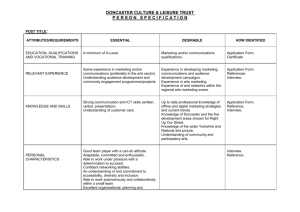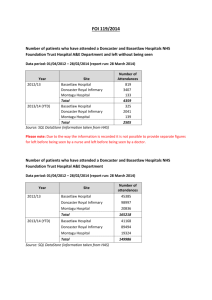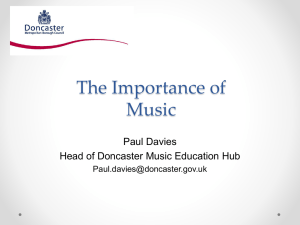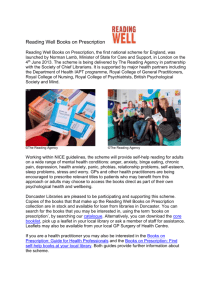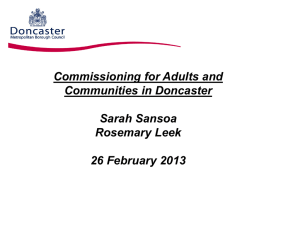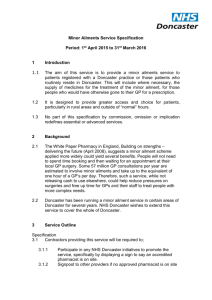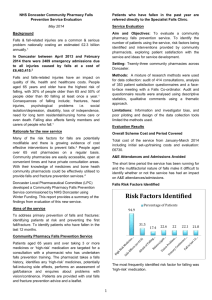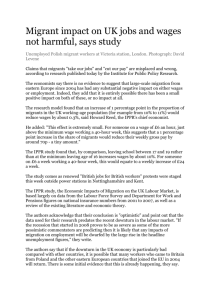Voluntary and Community Sector perspective –
advertisement
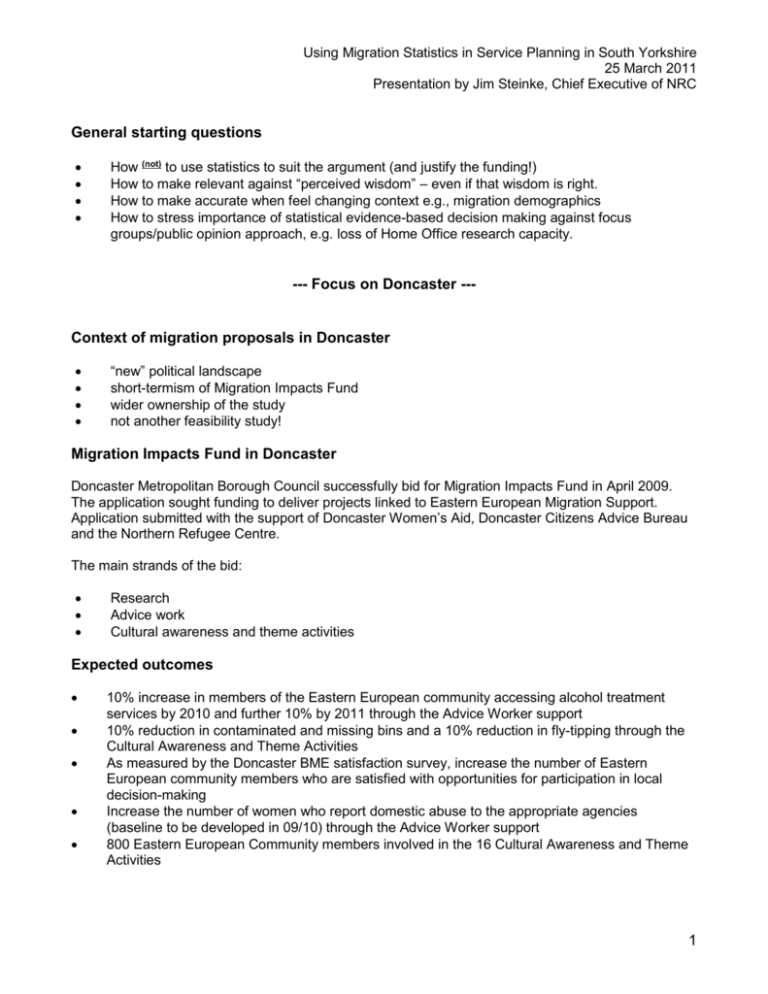
Using Migration Statistics in Service Planning in South Yorkshire 25 March 2011 Presentation by Jim Steinke, Chief Executive of NRC General starting questions How (not) to use statistics to suit the argument (and justify the funding!) How to make relevant against “perceived wisdom” – even if that wisdom is right. How to make accurate when feel changing context e.g., migration demographics How to stress importance of statistical evidence-based decision making against focus groups/public opinion approach, e.g. loss of Home Office research capacity. --- Focus on Doncaster --- Context of migration proposals in Doncaster “new” political landscape short-termism of Migration Impacts Fund wider ownership of the study not another feasibility study! Migration Impacts Fund in Doncaster Doncaster Metropolitan Borough Council successfully bid for Migration Impacts Fund in April 2009. The application sought funding to deliver projects linked to Eastern European Migration Support. Application submitted with the support of Doncaster Women’s Aid, Doncaster Citizens Advice Bureau and the Northern Refugee Centre. The main strands of the bid: Research Advice work Cultural awareness and theme activities Expected outcomes 10% increase in members of the Eastern European community accessing alcohol treatment services by 2010 and further 10% by 2011 through the Advice Worker support 10% reduction in contaminated and missing bins and a 10% reduction in fly-tipping through the Cultural Awareness and Theme Activities As measured by the Doncaster BME satisfaction survey, increase the number of Eastern European community members who are satisfied with opportunities for participation in local decision-making Increase the number of women who report domestic abuse to the appropriate agencies (baseline to be developed in 09/10) through the Advice Worker support 800 Eastern European Community members involved in the 16 Cultural Awareness and Theme Activities 1 Using Migration Statistics in Service Planning in South Yorkshire 25 March 2011 Presentation by Jim Steinke, Chief Executive of NRC Doncaster MIF steering group membership: Doncaster citizens – migrant communities and non-migrant communities – via Doncaster Focus Group South Yorkshire Police NHS Doncaster DMBC Strategic Housing Northern Refugee Centre UK Border Agency DMBC Community Safety Doncaster Citizens Advice Bureau Doncaster Women’s Aid St Leger Homes of Doncaster DMBC Adult Services DMBC Children’s Services Job Centre Plus Faith Group representation The Research Strand The contract for the Eastern European Migrant Population Research in Doncaster was successfully tendered to Dr Deborah Sporton of the University of Sheffield, and was completed in March 2010. This population research work aimed to provide greater clarity on: The approximate number of Eastern European migrant workers currently living/working in Doncaster, including a demographic breakdown according to age, gender, sector, wage rate, occupation, hours worked, whether work is temporary or permanent, planned duration of stay and dependents. This data will be collated primarily from secondary data sources which includes Worker Registration Scheme Data, National Insurance Numbers allocated to overseas nationals, Seasonal Agriculture Workers Scheme and Sector Based Scheme, National Health Service Central Register and Schools Census Data. Identification of the hubs/networks/links/routes into communities along with the places of work, schools, worship, social activities, neighbourhoods, and other hubs/community networks, in Doncaster where Eastern European migrants are working/living/socialising Information to help develop a picture of migration flows in and around Doncaster, including pull factors, countries of origin and destinations, and duration of stay. An improved understanding of the issues facing legal Eastern European migrants living and working in Doncaster The research focused on: Population dynamics/profiles to increase knowledge and understanding of current migrant communities. Research into extent and perception of domestic violence among (Eastern European) migrant communities, and of support services Research into alcohol abuse misuse among (Eastern European) migrant communities and care pathways Research briefs for all three pieces of work were developed. Proposed timescales: - Population dynamics: January – March 2010 - Domestic violence: March - April 2010 - Alcohol abuse: March - April 2010 2 Using Migration Statistics in Service Planning in South Yorkshire 25 March 2011 Presentation by Jim Steinke, Chief Executive of NRC The three focuses of the Research Strand (from the proposal paper): Population dynamics Doncaster’s demography has changed significantly in recent years with approximately 75 different languages being spoken reflecting many new cultures and opportunities as well as challenges. Economic migration, both into and out of the UK since EU expansion, has led to a diverse and complex population. It is nationally and locally recognised that work is needed to better understand the communities that make up our towns and cities. Current population estimates are recognised to be inadequate in relation to the scale of the issues faced e.g. in relation to community cohesion. A research project to increase our knowledge of, and links with, Doncaster’s different communities is an essential step to success in the other projects under the Migration Impacts Fund. This will include not only population / community estimates by number and geography, but also detailed information about: The networks that have led to new communities establishing in Doncaster The reasons for migration to Doncaster from other parts of Europe, and the intentions of these communities in the short and long-term The major problems and opportunities experienced by these communities – and service providers Links are currently being made with Barnsley MBC, and other neighbouring authorities, with a view to collaborative/compatible research projects. All of the research work will be used to inform and develop ongoing mainstream provision, thereby leaving a legacy of sustainability. The geographic areas that this research project will predominantly focus on in Doncaster are the Town Centre, Balby, Wheatley, Hyde Park and Hexthorpe, as these are currently recognised as the main settlements for new migrant communities. Domestic violence This research brief is being developed in partnership with Community Safety and the Violent Crime Theme Group/Domestic Violence Working Party. Its findings will directly relate to the ongoing provision of services by these partnerships. The aim of the domestic violence research strand is to: Increase partners’ understanding of the extent and impact of domestic violence within migrant communities, particularly economic migrants from Eastern European communities Clarify/understand the migrant communities’ perceptions of domestic violence, and what encourages or prevents victims in seeking support Establish whether migrant communities perceive domestic violence as a crime - and whether they are aware of the support that is available in its broadest sense (for example, sign-posting, counselling, IDVA, proactive policing etc). The research will include identification of community members who may go on to play a central ‘active citizenship’ role in championing, raising awareness, building confidence and empowering the Eastern European communities to report all levels of domestic abuse to the appropriate agencies in Doncaster. 3 Using Migration Statistics in Service Planning in South Yorkshire 25 March 2011 Presentation by Jim Steinke, Chief Executive of NRC Finally, using the findings from the research, it will make clear recommendations for a communications plan specifically for migrant communities (in particular Eastern European migrants). The communications plan developed will link to the aims and implementation plan of the Domestic Violence Strategy 2008-11, and to the communications plan being developed by the Safer Doncaster Partnership Confidence team. The ultimate aim of this will be to increase understanding within the communities of domestic violence as a crime and the support that is available to its victims, from referral stage through to successful prosecution of perpetrators. The work will therefore contribute to the overarching aims of the Domestic Violence Strategy. Alcohol abuse This research brief is being developed in partnership with the alcohol strategic implementation group and key commissioners in NHS Doncaster. The aim of the alcohol abuse research strand is to: Increase partners’ understanding of the extent and impact of alcohol (and substance?) abuse among migrant communities, particularly economic migrants from Eastern European communities. Identify steps to assist in preventing alcohol abuse among these communities and increasing access to treatment (tiers 1 – 3). Within this research programme there will be the potential to develop a specific, culturally appropriate, care/treatment pathway for the Eastern European community. This research will be conducted in parallel with the domestic violence research work to maximise resources and access to community networks. Relevant National Indicators that were used (covering Stronger Communities, Safer Communities, Tackling Exclusion, and Promoting Equality) NI 1: % of people who believe people from different backgrounds get on well together in their local area NI 2: % of people who feel that they belong to their neighbourhood NI 3: Civic participation in the local area NI 4: % of people who feel they can influence decisions in their locality NI 5: Overall/general satisfaction with local area NI 6: Participation in regular volunteering NI 7: Environment for a thriving third sector NI 13: Migrants English language skills and knowledge NI 15: Serious violent crime rate NI 26: Specialist support to victims of a serious sexual offence NI 32: Repeat incidents of domestic violence NI 41: Perceptions of drunk or rowdy behaviour as a problem NI 115: Substance misuse by young people NI 140: Fair treatment by local services 4
